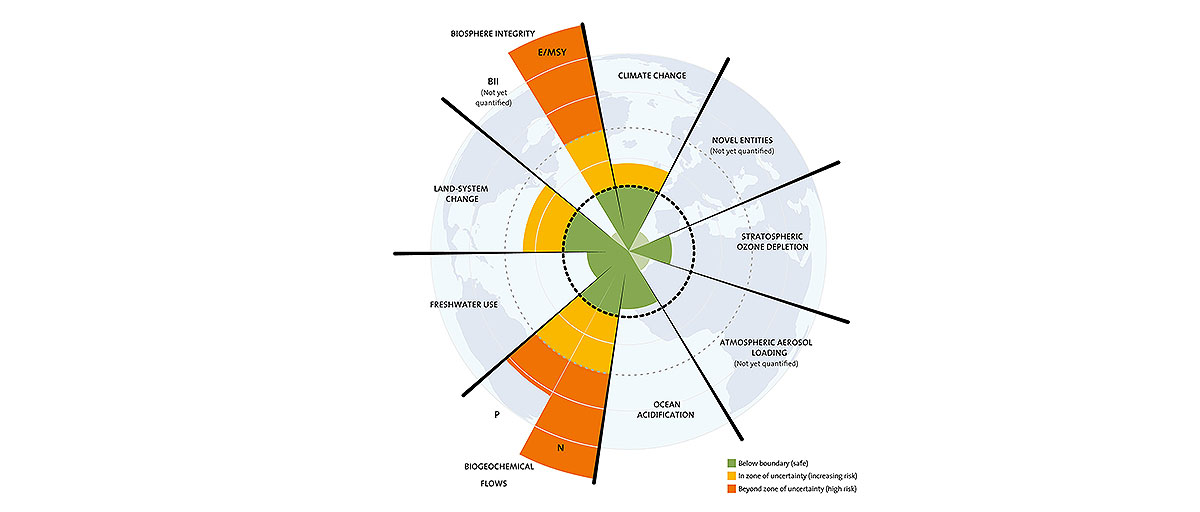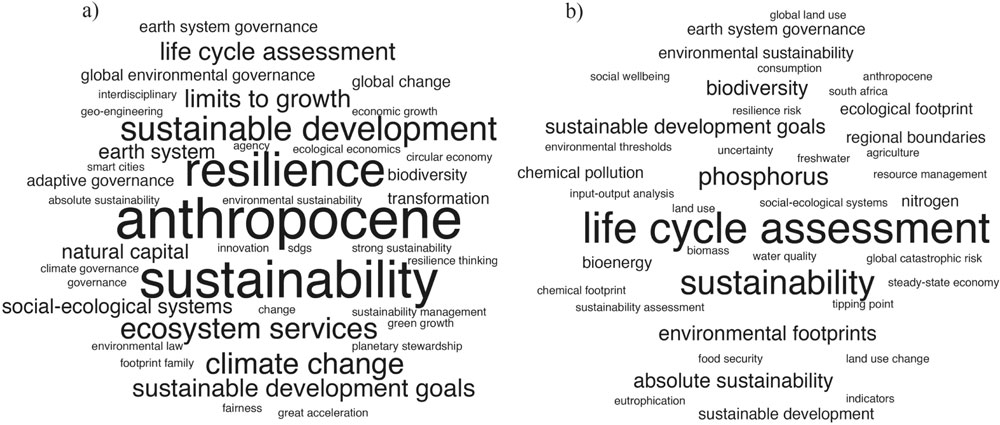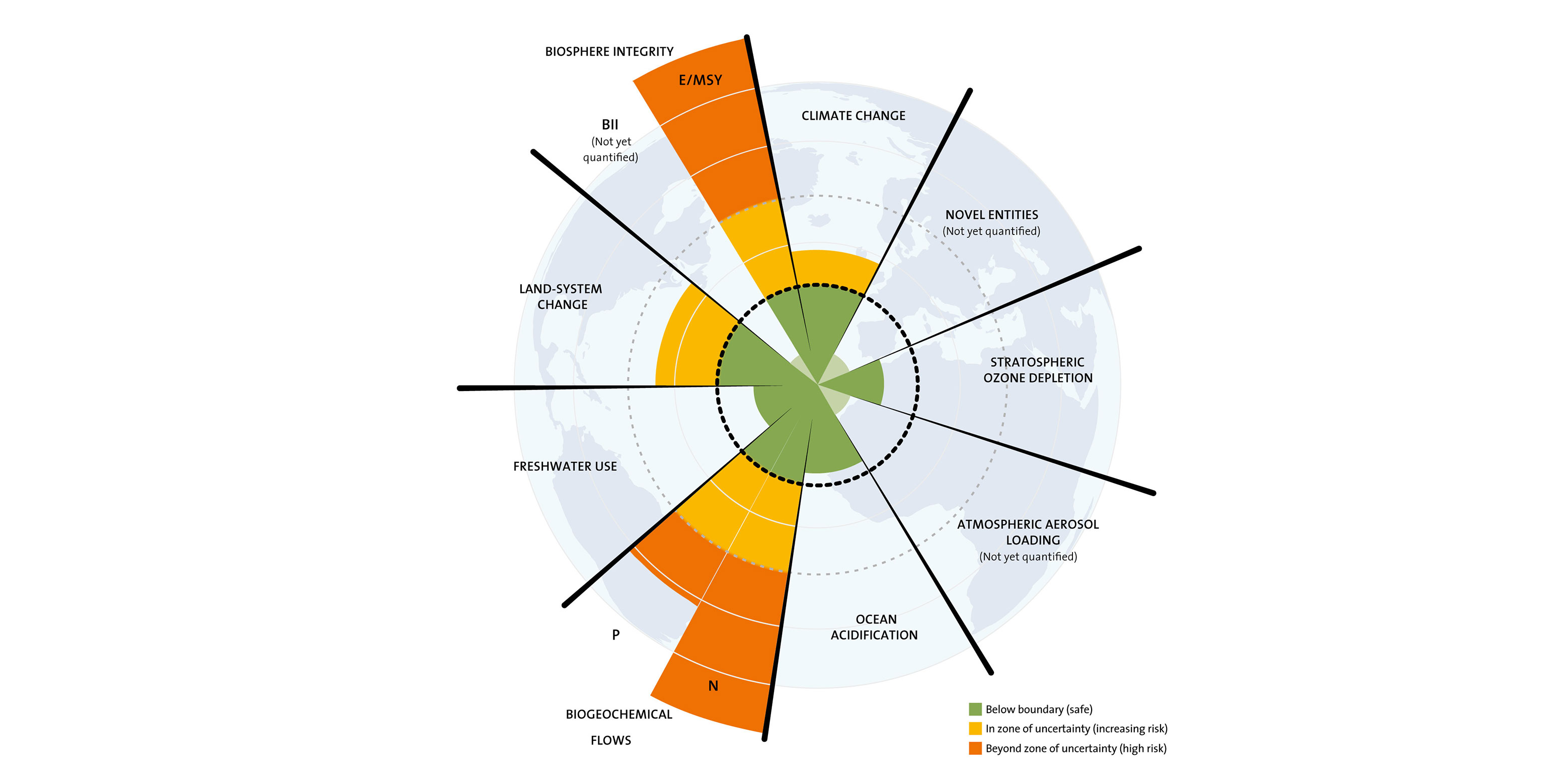
A new analysis of the Planetary Boundaries concept shows that the framing has focused discussion on maximum allowable impacts on the Earth system. This can overshadow an important role of the concept as a “signpost to a fundamentally different” route to sustainable development. Illustration: J. Lokrantz/Azote based on Steffen et al. 2015.
Bildtext får vara max två rader text. Hela texten ska högerjusteras om den bara ska innehålla fotobyline! Photo: B. Christensen/Azote
Planetary Boundaries
It’s all about the safe operating space
Ten years after the original publication of the Planetary Boundaries concept, researchers makes an in-depth analysis of academic research and discussion generated by the concept
- Researchers analysed the paper’s citations to assess the academic research and discussion sparked by concept
- A main finding is that the “planetary boundaries” framing has focused discussion on maximum allowable impacts on the Earth system rather than as a “signpost to a fundamentally different” route to sustainable development
- A crucial area for future research lies in designing tools with which to implement the concept
The Planetary Boundaries concept will be ten years old in September 2019. What impact has it had in academia? To answer that question, researchers at the centre analysed the paper’s citations to assess the academic research and discussion sparked by concept – a discussion that is still going strong.
"The high number of citations of the Planetary Boundaries papers reflects how much demand there is for sustainability concepts. We wanted to assess if the planetary boundaries concept meets those needs and how," says lead author Andrea Downing.
In 2009, the paper “A safe operating space for humanity” was published in Nature, followed by a longer article in Society and Ecology. The papers proposed a new Earth system framework for risk management under uncertainty called the Planetary Boundaries Framework. As of 6 May 2019, these two papers have been cited 3885 times according to the Web of Science.
A signpost to a different route
A main finding from the research is that the planetary boundaries framing has focused discussion on maximum allowable impacts on the Earth system. This can overshadow an important role of the concept as a “signpost to a fundamentally different” route to sustainable development, one which acknowledges a Holocene-like Earth system as a prerequisite for future development.
“The emphasis needs to be on the “safe operating space”, not the limits,” suggests Downing.
Downing and colleagues separated the research papers into three main groups. The first group, “commentaries”, was the biggest collection of papers. Here, researchers have, for example, used the planetary boundaries concept to underpin their own arguments relating to human impact on the Earth system, or described the challenges that different contexts bring to applying planetary boundaries research. The second basket contained papers that advanced the planetary boundaries concept as an Earth system framework. The final group explored how to use the concept, for example to apply it at national or regional scales or explore links to social dimensions, such as behaviours, impacts, needs or aspirations.
The social and human dimensions are implicit in the original papers. However, we find that to apply the concept, these dimensions must be made explicit. We suggest a framework to better include human dimensions, bridging between the research on the concept itself and parallel advances from the social sciences
Andrea Downing, lead author
Applying and criticizing the concept
The researchers found that three boundaries attracted the most critique: biodiversity, land use and water. One paper, for example, by leading biodiversity expert Georgina Mace from Imperial College, London, challenged the biodiversity metrics used and suggested alternatives. These were later incorporated into the first major update of the boundaries concept in 2015. In 2013, Dieter Gerten from the Potsdam Institute for Climate Impact Research in Berlin, and colleagues, queried the water boundary and suggested that human freshwater usage may be lower than previous estimates.
Two boundaries have remained unquantified: chemical pollution (now “novel entities” such as herbicides, pesticides, plastics, GMOs) and aerosol loading (small particles in the atmosphere). To date, only the chemical pollution boundary has spurred further research. The core planetary boundaries team, though, plans a series of workshops on both boundaries in 2019/2020.
Over 70 papers focused on applying the concept, by including social dimensions and re-scaling the planetary level of the processes to the scales at which sustainable development can be enacted. Downing and team categorise these papers according to four terms: needs, aspirations, behaviours and impacts.
Most research focuses on impacts of human activities on planetary boundary processes, for example impacts of agriculture on land-use or water systems. Other research questions centre on matching boundary values to human needs – for instance water or food requirements – or seeks to derive what social transformations (behaviours) can lead away from boundaries. A small but highly relevant fraction of the literature matches social goals to the boundaries (aspirations, e.g. Raworth).
Downing adds, “To shift from a boundary focus to a safe operating space focus we need to bring out the human dimensions and interrogate what sustainable futures look like, for whom, where and who can or should contribute to building them.”

Word clouds created with keywords of articles (when available) (a) in Commentary articles and (b) in Applications articles. Font sizes reflect absolute frequency of appearance of words in article keywords (note: the researchers excluded the terms 'planetary boundary(ies)' and 'safe operating space' as well as keywords that appeared only once—see supplementary materials for details).
Design tools to implement the concept
The Planetary Boundaries concept has clearly provided a much-needed platform for research on issues of sustainable development. It has triggered widespread and interdisciplinary research and increased awareness of global sustainability challenges. There is nonetheless still more talk than action in terms of developing the concept for use, which clearly shows that the task at hand is not trivial.
Downing and her team identify that a crucial area for future research lies in designing tools with which to implement the concept, addressing human dimensions and understanding the interdependencies between social-ecological processes that shape safe-operating spaces.
Indeed, commonly used footprints approaches fail to account for the interdependences of Earth system processes that is central to the concept, and leaves behind the resilience framing that is essential to navigating safe operating spaces for humanity.
Methodology
The researchers used Web of Science to identify references that cite the original PBc publications by Rockström et al (2009a, 2009b)—777 and 3108 references respectively—accessed on 6 May 2019. They selected those that use terms 'planetary boundaries' or 'safe operating space' in title, abstract, and/or keywords. They manually excluded a foreign language reference, a reprint, as well as references that only summarily mention the concept. They added references the were aware of, that cite the concept and/or are themselves cited in this context—but that do not appear in Web of Science (e.g. Raworth 2012, Crépin and Folke 2014, Fanning and O'Neill 2016). They managed to obtain a total of 224 references (figure 1—note that 2 response articles are excluded from the count). Their assumption is that they selected only articles that explicitly apply and build on the PBc. Although the literature search potentially missed some relevant research, they believe that our selection gives a comprehensive overview of academic research carried out on the PBc.
Downing, A., Bhowmik, A., Collste, D. Cornell, S.E., Donges, J., et.al. 2019. Matching scope, purpose and uses of planetary boundaries science. Environ. Res. Lett. 14 073005. DOI: 10.1088/1748-9326/ab22c9








